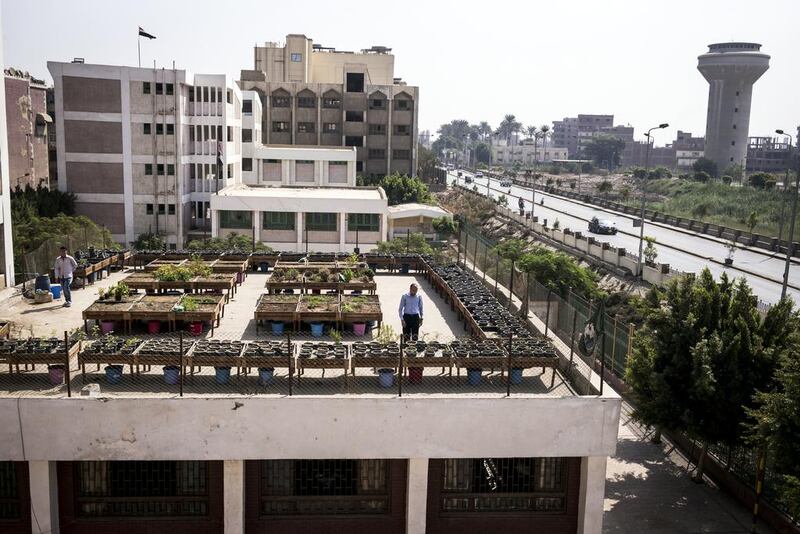It shouldn’t be difficult. They were doing it in Cairo a millennium ago.
When the Persian traveller Nasir Khusraw visited the Egyptian capital in about 1050, he wrote in his book the Safarnama that residents in the wealthy and densely populated area of Fustat had put gardens on the tops of their high-rises. The tallest of the buildings stood 14 storeys, and the gardens were irrigated using ox-drawn water wheels placed below.
Over the last few years, the idea of rooftop gardening in Egypt has re-emerged and become all the rage. International donors have jumped on to the bandwagon. And what’s not to like about it? Wouldn’t it be wonderful to be rid of the ugly satellite dishes and mountains of junk that have accumulated on the wonderfully flat roofs of Cairo, a city with very few green spaces, and replace them with luxuriant gardens producing vegetables for the poor?
It is an idea that fires the imagination. Yet despite the best intentions, it is one that sadly will almost certainly not fly in Egypt, at least not anytime soon. International donors might be well advised to put their money and energy somewhere else.
The potential benefits are obvious. In addition to improving general aesthetics, green roofs act as insulation, which is not usually a factor in Egypt construction – especially in poorer neighbourhoods, where top- floor apartment are usually ovens.
Green roofs absorb heat from the environment as a whole. The ubiquitous asphalt and concrete can increase the temperature of a city by three or four degrees compared to that of surrounding farmland.
A garden can also absorb heavy metals and other pollutants from the air, although that may not be such a great sell if you are producing crops for the table.
And on a social level, green roofs can transform the roof into a delightful communal space for residents.
The idea of rooftop gardening has been gaining popularity around the world as well as in Egypt. The American University in Cairo’s Rise institute offered a full-day training session to the public last month on designing and implementing rooftop gardens in Cairo, for 1,300 Egyptian pounds (Dh609) per person. The German government aid organisation GIZ has supported a rooftop farming pilot project in the informal Cairo district of Ezbet El Nasr.
But the problems are myriad. One of the biggest is ownership. Very few buildings in Cairo are properly registered, especially in the poorer neighbourhoods where rooftop crops might provide the most benefit. Deciding who has the right to the roof is an obstacle.
Then there is the problem of who is responsible for the services. Many of the electricity metres in poor areas are not registered under the name of the owner. Water metres tend to be communal, so all the building’s tenants can end up financing the people irrigating and harvesting the crops on the roof.
The structure of buildings is also a concern. Many are incredibly poorly built, and it is a question whether they can support the extra weight of a rooftop farm, let alone endure the almost inevitable water leakage.
There is also the cost, with a rooftop garden system cost ing from 7,000 to 15,000 pounds, according to some reports.
Sherif Hosny, the chief executive of Schaduf, which bills itself as the leading green roof and wall garden company in Egypt, says his company began a pilot project in Cairo’s Bulaq district in 2012, with a non-governmental organisation lending a hand.
Their original idea had been to set up 100 rooftop gardens to grow produce, which the urban farmers would then sell back to back to a cooperative store in the upmarket neighbourhood of Maadi. But almost immediately the project hit problems.
“In poorer areas, there are usually complicated ownership issues. People rarely have the proper documentation,” says Mr Hosny, whose company has also received support from GIZ.
Microfinance organisations usually ask for three things before lending – an identification card, non-family references and an electricity bill. Schaduf had trouble finding people who could provide these. In one neighbourhood it could only find two people who could fulfil all three criteria. The Bulaq project fizzled out.
Schaduf turned instead to setting up vertical gardens and ornamental rooftop gardens for the rich, and it says business is booming.
These include a bank, CIB, which had Schaduf create a vertical garden at its branch in the Smart Village, then later a garden on its rooftop as well that transformed the space to one that could be used for events. In a nod to sustainability, the CIB garden included food crops – but ones that were ornamental, such as ginger.
Schaduf then moved to other high-end clients such as malls, private villas and property developers wanting vertical green walls as part of landscaping.
As often happens, good intentions to help the poor get lost in the reality on the ground.
“It appeals to a certain social conscience,” says one Cairo-based urban specialist. “But it is not plain sailing.”
As was the case in the Fatimid city 1,000 years ago, it will probably be mainly the rich who partake of Cairo’s few rooftop gardens.
Patrick Werr has worked as a financial writer in Egypt for 25 years.
Follow The National's Business section on Twitter





